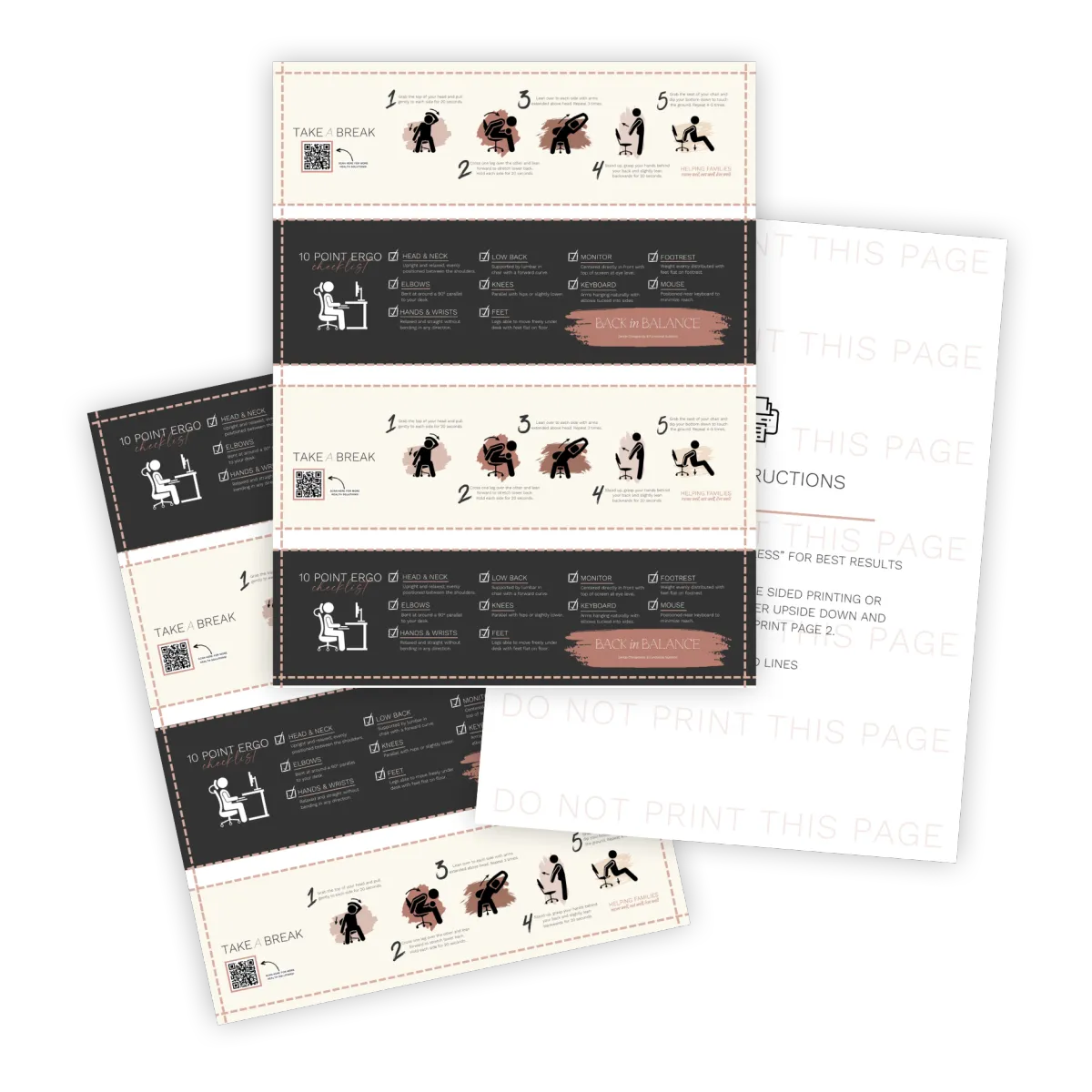

Apple Trackpad

Apple Keyboard


Are you wanting to get pregnant or expecting a little one? Get out free checklist today. This Ultimate Fertility and Pregnancy Checklist gives you everything you need to know for optimized health.

Unlock the secrets to managing stress with our Overcoming Stress Mini Course. Learn how to leverage your nervous system to reduce anxiety and improve well-being. Join today for quick, effective stress relief strategies. Perfect for busy individuals seeking a healthier, stress-free life.

Are you wanting to get pregnant or expecting a little one? Get out free checklist today. This Ultimate Fertility and Pregnancy Checklist gives you everything you need to know for optimized health.

Do you ever feel stiff and sore from sitting all day? If so, download our printable bookmark and walk through the 10 point ergonomic checklist to help you get back in balance from anywhere!





Debunking 5 Common Myths About the Second Trimester of Pregnancy
The second trimester of pregnancy is often called the "golden trimester," but this phase comes with its fair share of myths. Let’s separate fact from fiction by addressing five common second-trimester myths and what they really mean for your pregnancy.
Myth 1: The Second Trimester Is Perfect
While many women experience relief from first-trimester nausea, the second trimester isn’t always a walk in the park. Symptoms like back pain, leg cramps, heartburn, or sinus congestion can still appear.
Think of Your Body as a Dashboard:
Symptoms are like warning lights, signaling areas that might need attention. Instead of ignoring these signs, take time to address them before they grow into bigger issues.
Myth 2: Waking Up to Use the Restroom Is Normal
Frequent bathroom trips at night might seem inevitable, but in most of the second trimester, this isn’t caused by your baby. Instead, it could be a sign of dehydration.
Pro Tip: Add a small pinch of Himalayan or sea salt to your water. This helps your body absorb water into your tissues, reducing those nighttime interruptions.
Myth 3: Cravings Are Normal During Pregnancy
Cravings and aversions might feel like a classic part of pregnancy, but they’re more common than they are normal. Often, they’re signs your body is struggling to digest certain nutrients like carbohydrates, fats, or proteins.
What to Do: Instead of avoiding foods you crave or find unappealing, work on supporting your digestion so your body can absorb nutrients effectively.
Myth 4: You Can’t Prevent Gestational Diabetes
Gestational diabetes isn’t just about genetics or past pregnancies. Your lifestyle and how well your body manages carbohydrates play a significant role.
Start Early: Focus on breaking down carbohydrates effectively and supporting your pancreas for better insulin regulation. Pay attention to bowel movements and overall digestion to minimize stress on your body.
Myth 5: Stick to Gentle Exercise Only
While prenatal yoga is excellent, your body also needs strength training to prepare for the physical demands of parenthood.
Movement Matters:
Practice lifting with proper biomechanics (bend from your knees and hips, not your back).
Incorporate movements that build strength to prepare for lifting and caring for your baby.
Pregnancy is a time of transformation, and understanding these myths can help you approach it with confidence. For more in-depth guidance, check out the Move Well, Eat Well, Live Well Course—linked below!
Join us next week as we debunk even more myths about pregnancy.

Debunking 5 Common Myths About the Second Trimester of Pregnancy
The second trimester of pregnancy is often called the "golden trimester," but this phase comes with its fair share of myths. Let’s separate fact from fiction by addressing five common second-trimester myths and what they really mean for your pregnancy.
Myth 1: The Second Trimester Is Perfect
While many women experience relief from first-trimester nausea, the second trimester isn’t always a walk in the park. Symptoms like back pain, leg cramps, heartburn, or sinus congestion can still appear.
Think of Your Body as a Dashboard:
Symptoms are like warning lights, signaling areas that might need attention. Instead of ignoring these signs, take time to address them before they grow into bigger issues.
Myth 2: Waking Up to Use the Restroom Is Normal
Frequent bathroom trips at night might seem inevitable, but in most of the second trimester, this isn’t caused by your baby. Instead, it could be a sign of dehydration.
Pro Tip: Add a small pinch of Himalayan or sea salt to your water. This helps your body absorb water into your tissues, reducing those nighttime interruptions.
Myth 3: Cravings Are Normal During Pregnancy
Cravings and aversions might feel like a classic part of pregnancy, but they’re more common than they are normal. Often, they’re signs your body is struggling to digest certain nutrients like carbohydrates, fats, or proteins.
What to Do: Instead of avoiding foods you crave or find unappealing, work on supporting your digestion so your body can absorb nutrients effectively.
Myth 4: You Can’t Prevent Gestational Diabetes
Gestational diabetes isn’t just about genetics or past pregnancies. Your lifestyle and how well your body manages carbohydrates play a significant role.
Start Early: Focus on breaking down carbohydrates effectively and supporting your pancreas for better insulin regulation. Pay attention to bowel movements and overall digestion to minimize stress on your body.
Myth 5: Stick to Gentle Exercise Only
While prenatal yoga is excellent, your body also needs strength training to prepare for the physical demands of parenthood.
Movement Matters:
Practice lifting with proper biomechanics (bend from your knees and hips, not your back).
Incorporate movements that build strength to prepare for lifting and caring for your baby.
Pregnancy is a time of transformation, and understanding these myths can help you approach it with confidence. For more in-depth guidance, check out the Move Well, Eat Well, Live Well Course—linked below!
Join us next week as we debunk even more myths about pregnancy.
Sign up for our no spam newsletter.
Stay Connected
©2025 Back In Balance Health. All Rights Reserved. – WEBSITE By: Danielle Damrell Creative Collective, Inc.


